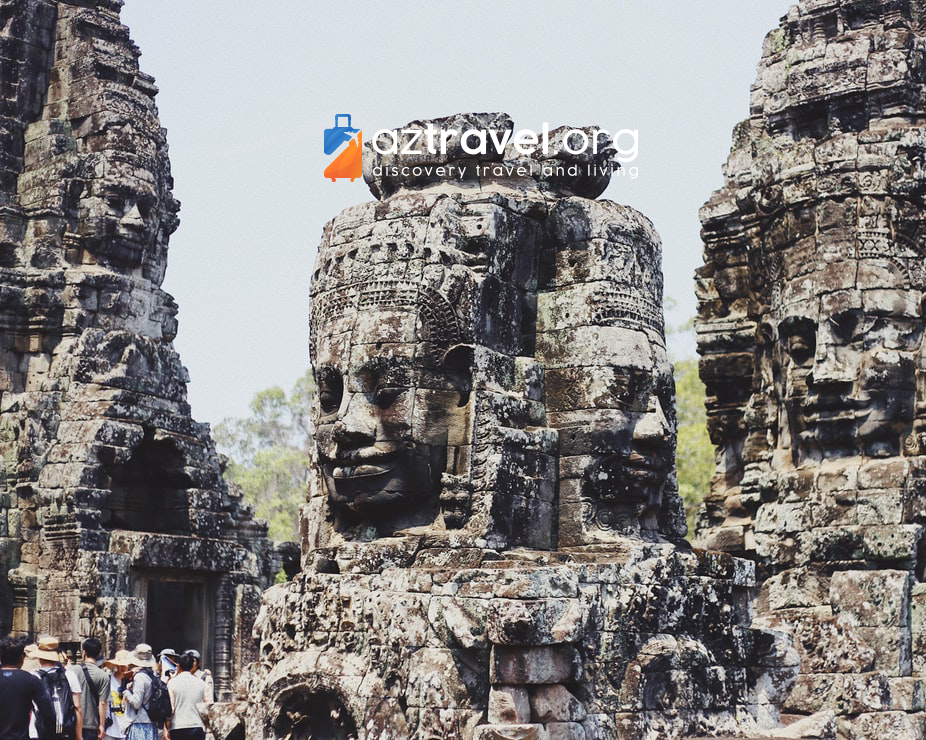The temple complex of Angkor Wat is one of the wonders of the world and is also a very famous tourist destination in Cambodia. This place each year attracts thousands of visitors to visit and explore. If you travel to Cambodia without visiting Angkor Wat, you are already missing 50% of the meaningful experience of the trip. So what’s interesting about this place?
Located in a jungle setting near the city of Siem Reap, Angkor Wat is known as the largest religious monument in the world, but its enormous size makes the Angkor population interesting. This relic was built by the Khme in the 12th century, with extremely unique architecture.

The site has an intriguing mix of unearthed and unexplored temples of various shapes, sizes, and decay, with some of the buildings having a paranormal appearance as they swallowed by trees and roots. Giant stone carvings look out in all directions. Spacious and complex frescoes run along the walls and doorways. The dilapidated paths and steep stone steps invite you to explore.
This particularly important complex of Angkor monuments of Cambodia tourism is divided into 5 main areas with unique architecture that create a magnificent sight that attracts tourists: Angkor Wat and Angkor Thom, Little Circuit , Big Circuit, Roluos group, and peripheral temples.
Angkor Wat is the temple with the most monumental architecture in the entire population with the main entrance in the west direction towards the sunset. Angkor Wat temple has 398 rooms, connected by 1,500m of corridor. Above, 5 towers are connected to each other by 3 architectural floors, of which the tallest tower is up to 65m, 4 sub towers 40m high. The road leading to the main gate of Angkor Wat is also made of boulders 230m long, 10m wide and 5m high above the lake water on either side of the temple.
Angkor Thom was the most powerful capital of the ancient Khmer. Angkor Thom owns large temples and unique architectures such as Bayon Temple, Baphuon Temple, Phnom Bakheng Temple, Elephant Yard, King Lep’s Yard and 5 large gates leading to Angkor Thom.
Little Circuit – this area has the most famous temple is the “old” temple Ta Prohm, where the creation of nature blends with human works. The branches and roots of the ancient trees grow intermixedly, covering the temple, creating an ancient spectacle, attracting tourists to Cambodia.
Big Circuit – this area also has a Preah Khan temple similar to Ta Prohm temple: stone walls mixed with old old tree stumps. In addition, in Big Circuit there is also an ideal place to watch the sunset, Pre Rup Temple, this is also a memorable experience that you should try when arriving at Angkor Wat.
The Rolous group is a complex of unique ruins belonging to the ancient city of Hariharalaya, older than Angkor, in which the Bakong temple with pyramid architecture is the most prominent.
Peripheral temples – this area is located quite far from the center of the temple complex of Angkor Wat but has the most unique and different works. Banteay Srei Temple was built mainly of red sandstone, a pigment added to the meticulously decorated wall sculptures, which are still visible today.
Ruins of Kbal Spean, also known as the site of 1000 linga (linga is a symbol of worship of the Indus valley civilization), with rocky outcrops lying under the stream water in a square area among trees.
Beng Mealea Temple is a relic close to nature, with plants blooming on ancient architecture, creating a fresh but murky atmosphere.
Phnom Krom Temple is located on a hill overlooking the Tonle Sap Lake.
Before its fall in the 15th century, Angkor Wat was named the largest city in the world. The complex is very large, and you may want to spend a few days touring the site.



GIPHY App Key not set. Please check settings